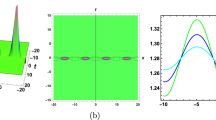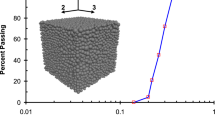Abstract
The Alekseevskii–Tate model is the most successful semi-hydrodynamic model applied to long-rod penetration into semi-infinite targets. However, due to the nonlinear nature of the equations, the rod (tail) velocity, penetration velocity, rod length, and penetration depth were obtained implicitly as a function of time and solved numerically. By employing a linear approximation to the logarithmic relative rod length, we obtain two sets of explicit approximate algebraic solutions based on the implicit theoretical solution deduced from primitive equations. It is very convenient in the theoretical prediction of the Alekseevskii–Tate model to apply these simple algebraic solutions. In particular, approximate solution 1 shows good agreement with the theoretical (exact) solution, and the first-order perturbation solution obtained by Walters et al. (Int. J. Impact Eng. 33:837–846, 2006) can be deemed as a special form of approximate solution 1 in high-speed penetration. Meanwhile, with constant tail velocity and penetration velocity, approximate solution 2 has very simple expressions, which is applicable for the qualitative analysis of long-rod penetration. Differences among these two approximate solutions and the theoretical (exact) solution and their respective scopes of application have been discussed, and the inferences with clear physical basis have been drawn. In addition, these two solutions and the first-order perturbation solution are applied to two cases with different initial impact velocity and different penetrator/target combinations to compare with the theoretical (exact) solution. Approximate solution 1 is much closer to the theoretical solution of the Alekseevskii–Tate model than the first-order perturbation solution in both cases, whilst approximate solution 2 brings us a more intuitive understanding of quasi-steady-state penetration.












Similar content being viewed by others
Change history
26 October 2018
In the original publication of this article, Eq. (20b) is incorrectly published due to the negligence of the author’s proofreading.
26 October 2018
In the original publication of this article, Eq. (20b) is incorrectly published due to the negligence of the author���s proofreading.
Notes
CTH: a software system under development at Sandia National Laboratories Albuquerque to model multidimensional, multi-material, large deformation, strong shock wave physics.
References
Allen, W.A., Rogers, J.W.: Penetration of a rod into a semi-infinite target. J. Franklin Inst. 272, 275–284 (1961)
Alekseevskii, V.P.: Penetration of a rod into a target at high velocity. Combust. Explos. Shock Waves 2, 63–66 (1966)
Tate, A.: A theory for the deceleration of long rods after impact. J. Mech. Phys. Solids 15, 387–399 (1967)
Tate, A.: Further results in the theory of long rods penetration. J. Mech. Phys. Solids 17, 141–150 (1969)
Christman, D.R., Gehring, J.W.: Analysis of high-velocity projectile penetration mechanics. J. Appl. Phys. 37, 1579–1587 (1966)
Hohler, V., Stilp, A.J.: Hypervelocity impact of rod projectiles with L/D from 1 to 32. Int. J. Impact Eng. 5, 323–331 (1987)
Rosenberg, Z., Dezel, E.: The relation between the penetration capability of long rods and their length to diameter ratio. Int. J. Impact Eng. 15, 125–129 (1994)
Anderson, C.E., Walker, J.D., Bless, S.P., et al.: On the L/D effect for long-rod penetrators. Int. J. Impact Eng. 18, 247–264 (1996)
Anderson, C.E., Walker, J.D.: An examination of long-rod penetration. Int. J. Impact Eng. 11, 481–501 (1991)
Walker, J.D., Anderson, C.E.: A time-dependent model for long-rod penetration. Int. J. Impact Eng. 16, 19–48 (1995)
Rosenberg, Z., Marmor, E., Mayseless, M.: On the hydrodynamic theory of long-rod penetration. Int. J. Impact Eng. 10, 483–486 (1990)
Zhang, L.S., Huang, F.L.: Model for long-rod penetration into semi-infinite targets. J. Beijing Inst. Technol. 13, 285–289 (2004)
Rosenberg, Z., Dezel, E.: Further examination of long-rod penetration: the role of penetrator strength at hypervelocity impacts. Int. J. Impact Eng. 24, 85–102 (2000)
Walters, W.P., Segletes, S.B.: An exact solution of the long-rod penetration equations. Int. J. Impact Eng. 11, 225–231 (1991)
Segletes, S.B., Walters, W.P.: Extensions to the exact solution of the long-rod penetration/erosion equations. Int. J. Impact Eng. 28, 363–376 (2003)
Forrestal, M.J., Piekutowski, A.J., Luk, V.K.: Long-rod penetration into simulated geological targets at an impact velocity of 3.0 km/s. In: 11th International symposium on ballistics, vol. 2. Brussels, Belgium (1989)
Walters, W., Williams, C., Normandia, M.: An explicit solution of the Alekseevskii–Tate penetration equations. Int. J. Impact Eng. 33, 837–846 (2006)
Orphal, D.L., Anderson, C.E.: The dependence of penetration velocity on impact velocity. Int. J. Impact Eng. 33, 546–554 (2006)
Orphal, D.L., Franzen, R.R.: Penetration of confined silicon carbide targets by tungsten long rods at impact velocities from 1.5 to 4.6 km/s. Int. J. Impact Eng. 19, 1–13 (1997)
Orphal, D.L., Franzen, R.R., Charters, A.C., et al.: Penetration of confined boron carbide targets by tungsten long rods at impact velocities from 1.5 to 5.0 km/s. Int. J. Impact Eng. 19, 15–29 (1997)
Sternberg, J., Orphal, D.L.: A note on the high velocity penetration of aluminum nitride. Int. J. Impact Eng. 19, 647–651 (1997)
Anderson, C.E., Riegel, J.P.: A penetration model for metallic targets based on experimental data. Int. J. Impact Eng. 80, 24–35 (2015)
Rosenberg, Z., Dezel, E.: Terminal Ballistics. Springer, Berlin (2012)
Anderson, C.E., Littlefield, D.L., Walker, J.D.: Long-rod penetration, target resistance, and hypervelocity impact. Int. J. Impact Eng. 14, 1–12 (1993)
Anderson, C.E., Orphal, D.L.: Analysis of the terminal phase of penetration. Int. J. Impact Eng. 29, 69–80 (2003)
Acknowledgements
The project was supported by the National Outstanding Young Scientist Foundation of China (Grant 11225213) and the Key Subject “Computational Solid Mechanics” of China Academy of Engineering Physics.
Author information
Authors and Affiliations
Corresponding author
Rights and permissions
About this article
Cite this article
Jiao, W.J., Chen, X.W. Approximate solutions of the Alekseevskii–Tate model of long-rod penetration. Acta Mech. Sin. 34, 334–348 (2018). https://doi.org/10.1007/s10409-017-0672-9
Received:
Revised:
Accepted:
Published:
Issue Date:
DOI: https://doi.org/10.1007/s10409-017-0672-9




